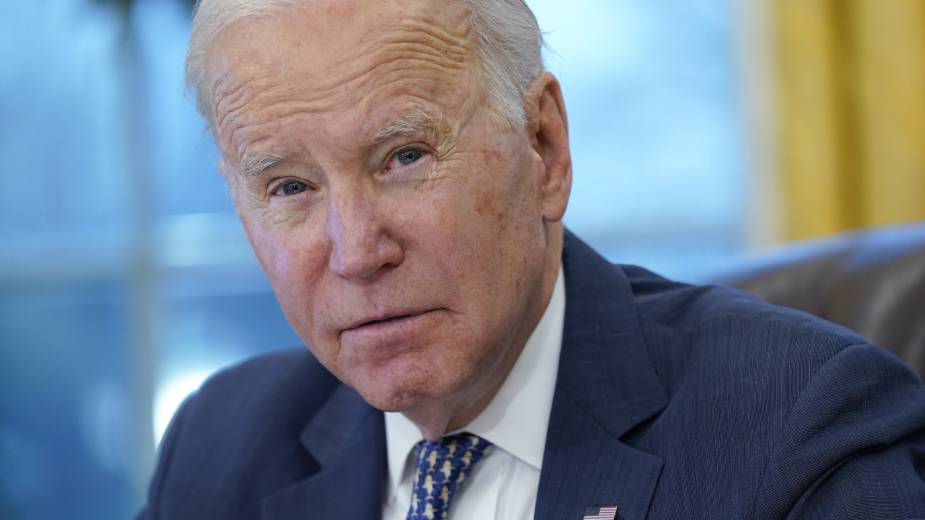Election Day Results in Red Shift for Mahoning Valley
YOUNGSTOWN, Ohio – If a durable realignment in the formerly staunchly democratic Mahoning Valley hasn’t already taken place, analysts say it’s certainly is trending in that direction.
The political realignment of the region “looks like it’s almost complete,” Paul Sracic, chairman of Youngstown State University’s department of political and international relations, said Wednesday, the day after the midterm elections.
Perhaps the clearest – though far from only – indication of a shift first evidenced by Republican presidential candidate Donald Trump’s victory in Trumbull County in 2016 was Republican U.S. Senate candidate J.D. Vance’s victory over the Democratic nominee, U.S. Rep. Tim Ryan, in both Mahoning and Trumbull counties, according to unofficial results.
Ryan, D-13 Ohio, was elected to represent the Ohio Senate district that included Trumbull County in 2000 and two years later was elected to the U.S. House of Representatives, where he had represented parts or all of Mahoning and Trumbull counties. In 10 elections for his congressional seat, though his vote share declined steadily since 2012, he won with less than 61% of the vote just three times, including twice – in his first race and 2010 – when he faced not only a Republican opponent but his predecessor, former congressman Jim Traficant, running as an independent.
His loss in the Valley comes on top of local Republican victories for state representative and senate, the District 7 Court of Appeals judgeship and a Trumbull County commissioner’s seat.
Potentially, a Mahoning County commissioner’s Democratic victory could be overturned by provisional ballots.
“It was a really good night for the Mahoning County Republican Party,” Tom McCabe,” Mahoning GOP chairman, reflected Tuesday night after the polls closed. The party carried nearly ever race in the county – including Vance’s victory over Ryan — and potentially could pick up the contested Mahoning County commissioner seat that was on the ballot once provisional ballots are counted.
Ryan “was the best candidate the Democrats could possibly field” to win back working-class voters in the Mahoning Valley and he was unable to do that. “So it really looks like the Valley is now red,” Sracic said.
There was an assumption that Trump’s 2016 victory over Democratic nominee Hillary Clinton in Trumbull – the first time since 1928 that the county had supported the Republican nominee for president — was “an outlier,” with voters driven by Trump’s specific message on trade, his populist message and “how he presented himself,” said Capri Cafaro, a faculty member at American University and former Democratic minority leader in the Ohio Senate.
In subsequent election cycles, Republicans have continued to gain ground at the local and state level, including the state senate seat she previously held, which flipped red in 2020, Cafaro pointed out.
Cafaro noted voters rejected veteran political names like Youngstown’s Bob Hagan, who had sought to reclaim the Ohio Senate seat he formerly held, and Warren’s Mike O’Brien, who ran for Trumbull County commissioner, an office he held for several years as well as serving as Warren’s mayor and as a state representative.
“So it’s clear to me that this isn’t just about Donald Trump,” she said. “Maybe it’s not even really about being Republican. Maybe it’s about a frustration that suggests that there’s been a loyalty to the Democrats that has been somewhat blind. … Maybe they feel that the Democratic Party hasn’t served them well.”
For many years, there wasn’t a “discernable Republican Party” outside Columbiana County locally. And over the past decade the party has fielded candidates that were successful in elections, Cafaro added. As solidified by Trump, the GOP in recent years “looks a bit different” than the establishment free-trade, pro-big corporation-type party of the past.
“The message of Republicans has changed,” she said.
The success of Republicans in local down ballot races is a sign that voters are moving beyond saying they will cast their ballot for Trump and instead saying they will vote for whomever the Republican candidate is, Sracic said.
“It’s no longer about Trump,” he said. “Now people feel more culturally aligned with the Republican Party.”
“Now we have one more test in two years,” when U.S. Sen. Sherrod Brown, a Cleveland area Democrat, is up for reelection, Sracic said. “If Brown loses in Mahoning and Trumbull counties, then you know we’re now the same as southern Ohio. We’re red.”
One problem that could face Democrats locally is candidate quality. As the Valley is grows more Republican, young people with political ambitions might choose to align themselves with the GOP because they think it will not be possible to win as a Democrat locally.
“Anytime you have a gubernatorial candidate that loses by 27%, that’s going to drag the entire ticket down,” said Christopher Anderson, chairman of the Mahoning County Democratic Party, pointing to Democrat Nan Whaley’s loss to incumbent Republican Gov. Mike DeWine.
“Had we not had a governor’s race that was called at 7:31 p.m., Tim’s [Ryan] race would have been much more competitive.” he added.
Anderson acknowledged Tuesday was “a bad night from a state perspective” but rejected the “grim” portrayal of the local results. He said the results from provisional ballots tend to follow the election day results, which show incumbent Mahoning County Commissioner Carol Rimedio-Righetti up by 200 votes over her GOP challenger, Geno DiFabio.
Also, Youngstown Councilwoman Lauren McNally won her bid for 64th district state representative, Bruce Neff of Canfield came within a few thousand votes of flipping a seat that was “literally gerrymandered” for state Rep. Al Cutrona, also of Canfield, Anderson said.
Additionally, addressing Ryan’s local losses, he said the congressman’s districts previously did not include some of the outlying – and more conservative — areas of Ohio so he hadn’t run in them before. The fact that Ryan outperformed Whaley showed that his message resonated with voters who cast their ballots for DeWine and then voted for him, Anderson said.
During a conference call Wednesday with journalists, Ohio Democratic Party Chairwoman Liz Walters echoed the sentiment that Ryan “ran one of the best races Ohio has seen,” taking on $50 million in outside spending from Republicans that could have been spent in other states, thereby potentially helping Democrats retain Senate control.
National Republicans were forced to spend money on the Ohio race when faced with Vance’s lackluster fundraising in comparison to Ryan’s numbers, Walters said.
“Ohio made that congressional red wave that so many predicted look like a ripple,” Walters said. Additionally, Tuesday’s results showed that when Ohio Democrats talk about the issues that matter to voters and show they are on their side, Democrats have a path to win in the state.
Walters acknowledged Democrats “came up short” in many races, having had to face “unprecedented obstacles” including millions of dollars in outside spending and “illegal gerrymandered maps.”
Ryan’s widely praised campaign “spoke directly to the needs of the electorate,” and channeled “a lot of being from the Valley”, with “straight-talking” rhetoric that focused on issues like trade and the economy without shying away from addressing other issues that concern Democrats, Walters said.
Asked about Ryan’s underperformance on his home turf compared with his overperforming every other Democrat running stateside and about the shifting party allegiance in the former Democratic bastion, Walters responded that it was important to point out the shift in performance statewide.
In a year with a “more negative national environment for Democrats,” Ryan matched or exceeded Biden’s 2020 margins in places like Franklin, Cuyahoga, Hamilton, Lucas and Summit counties and made “huge gains for Democrats in places like Lake and Medina counties, she said.
Conventional wisdom led many observers, including Cafaro, to anticipate “a bit of a bloodbath for Democrats” election night – based on factors including historical trends and President Joe Biden’s unpopularity — that ended up not coming to pass. She attributed the Democrats’ ability to stem losses to many Republican candidates being perceived as too extreme as well the concepts that “protecting democracy was on the ballot.” Combined with protecting individual rights, these issues turned out voters who might ordinarily have sat out the midterm election.
“We don’t know the final results yet but we know there’s no red wave,” Sracic said. “Given Biden’s low approval numbers, this should have been a very good Republican year and we don’t even know if they’re going to control the House after this. And they probably won’t control the Senate.”
Following Florida Gov. Ron DeSantis’s strong election performance and the perceived poor performance of many Trump-backed candidates, might lead Republicans to question whether Trump is “the right person” as they grapple with deciding on their standard bearer in the 2024 presidential contest.
“That is going to be a real argument amongst Republicans as they make their decisions for the nominee in the next 18 months,” Sracic said.
There will be recrimination among Republicans because of their lower-than-expected midterm performance, much of which will be directed at Trump because of his role in endorsing candidates, Sracic said.
“It might be that there is an extremely divisive primary in 2024 on the Republican side,” he continued. “If Trump doesn’t survive that primary and somebody else does, will the voters in Mahoning and Trumbull County who became Republicans under Trump be willing to switch to a new Republican candidate, somebody who went after the person who brought them in in the first place? That’s going to be a really interesting question when that happens.”
“The fact remains that we have work to do to take our state back and we’re not done fighting. We’re not done fighting for fair maps. We’re not done fighting for women’s right to choose. We’re not done fighting for voting rights. And we’re not done fighting for the dignity of work,” Walters said.
“And we’re all also very ready to fight for Sherrod Brown and his critical reelection campaign in 2024,” she continued. “Sherrod has proven time and again, that he knows how to win Ohio because voters know he’s on their side. Republicans who run against him do so at their own peril. Just ask Mike DeWine, Jim Renacci and Josh Mandel, three Republicans who have never lost a general election race in Ohio, except to Sherrod. 2024 is no different.”
In the recent election cycle, Democrats “really started to lay the groundwork” for how they “stem the tide” of Republican gains, Anderson said.
“We focused on pointing out that we’re the party that actually wants to improve individuals’ lives and give them real solutions to real problems like inflation, while the other side of the aisle is busy taking up all their time fighting culture wars.,” he said.
“We also started to rebuild the infrastructure that our party had kind of left fall to the wayside, whether it was improving our turnout operation, or whether it was improving the way that we communicate, for example,” he continued. “So now that we’ve laid that groundwork, we have to continue to scale it year after year after year, so that we continue to make those gains.”
Representatives of the Ohio Republican Party and Trumbull County Republican Party did not respond to requests to comment for this story in time for publication.
Copyright 2024 The Business Journal, Youngstown, Ohio.



